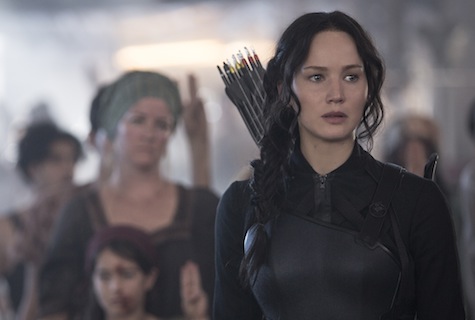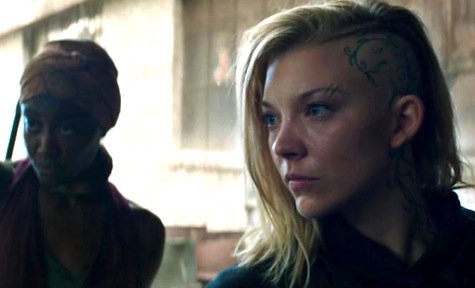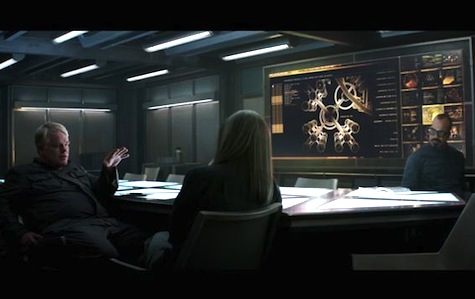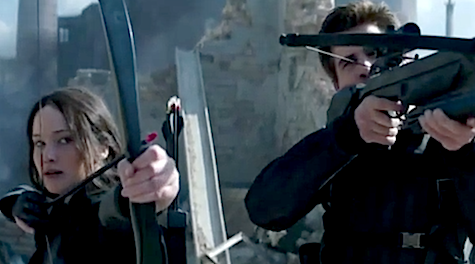While the choice to split Mockingjay, the final Hunger Games book, into two movies was clearly a move to make more money (ala Harry Potter and The Hobbit), the real question was always going to be whether or not Mockingjay had enough material to create two films. Interestingly, the filmmakers seem to have pulled it off with very little effort—simply by focusing on the fire that stokes a rebellion.
Minor spoilers for the film below.
Mockingjay concerns itself primarily with Katniss’ transformation into the Mockingjay propaganda figure for the war District 13 is hoping to wage on the Capitol. This is only used to frame the opening of war, and to introduce viewers to District 13. The more militant aspects of their way of life are perhaps not explored as thoroughly as they could have been, but that’s not really what this story is aiming to focus on—instead, it’s all about the game the Capitol plays, using Peeta as a response to Katniss’ every move as the Mockingjay. Jennifer Lawrence is raw as ever, giving over another arresting performance with no evidence that she remembers she’s acting a part at all.

Fans of the book will notice certain elements are missing in this story perhaps more than in the previous two films; we spend less time dealing with Katniss’ PTSD and the fallout from it immediately following the Quarter Quell, and we don’t get as much of a window into Gale’s change from rebel into militant yes man. Though it was always likely—since they had very limited roles in the previous movies—the capture and use of Katniss’ prep team from the games is not part of the story either, which is honestly a shame. It prevents certain gray areas of the Hunger Games arc from coming clear, depicting war doing what it does best—destroying both sides as viscerally as possible. Effie’s presence is treated more as comic relief, but that’s not a point of irritation, since the movie desperately requires reprieves where laughter is possible.
Fans likely recall that Philip Seymour Hoffman passed away this year, and the film is dedicated to him. He seems to have shot the majority of Plutarch Heavensbee’s role nevertheless, and is present through the majority of the movie, selling Katniss to District 13’s President Coin the way one would sell a sports star to an athletic equipment company. The filming of the propos (that’s propaganda films) is where the core of the film is focused, and it manages those scenes to tortured effect every single time. Having Natalie Dormer present as Cressida, the director of these little specials, makes for an immersive experience. Her voice is in Katniss’ ear the whole time (and therefore in the audience’s ear as well), urging her to share the emotions she has such difficulty expressing.

It works to stoke the audience’s expectations with the rest of Panem—confrontation rises alongside the audience’s outrage at what Katniss witnesses. Though some may be irritated at the choice to zero in on this aspect of the story, I’d argue that it makes for a compelling experience on screen. The Hunger Games films are in a better place to engage with how visual media manipulates people because that is what these films themselves are doing. This is an area where these films have the ability to be the most effective at exploring their text because they can do what the book cannot; they can show us what it looks—what it feels like—to be rallied into a frenzy over the sight of a hero shouting down an impossible giant.
Essentially, the opening of the book has been put under a microscope, and that close focus provides a unique opportunity to examine power dynamics. We can see the difference in how Katniss is framed, versus how Peeta gets framed by the Capital, and that is extended to how President Snow is juxtaposed against President Coin (and they are similar enough in their rhetoric and devices to make even the most unobservant viewer wince). The use of music is employed to chilling effect, moving from a simple song Katniss is prompted into to singing by a river (called “The Hanging Tree”) to its use in propaganda to how that provokes a reaction among Panem citizens. You will never get that song out of your head, and that is precisely the point the movie is making.

These films are at their best when they’re working with small touches, and yet again, this is where they shine. President Snow’s daughter silently pulling the Mockingjay braid from her hair when she learns it is no longer acceptable to support Katniss: Finnick’s repetitive knot-tying as he attempts to keep calm, Peeta’s wardrobe choices, which first make him appear as though he has a dagger to his throat, then later look as though they’re choking him. We do miss out on seeing more of the Capitol this time around, though that will likely be remedies in the next film.
Julianne Moore gives a no-bones-about-it performance of President Coin, and her subtlety plays well next to Katniss’ hurt and rage. Because the theme of manipulation is front and center on this outing, very few characters seem safe outside of Prim and Gale. Haymitch is perhaps a bit underused, and one does have to wonder if President Snow hasn’t become a little too on-the-nose in terms of scenery-chewing, but Donald Sutherland still appears to have enjoyed himself. The violence in the film is some of the most visceral we’ve seen thus far, and that’s saying something. It comes to the forefront right at the end, and makes the placement of the film’s ending work better than it might have otherwise.

The next film will demand a lot less pondering and a lot more movement, so we’ll see what Part II brings and how this movie nestles in with the other three. In the meantime, beware: Fire is catching.
Emmet Asher-Perrin could use a drink (wth Haymitch) now, if you please. You can bug her on Twitter and Tumblr read more of her work here and elsewhere.










